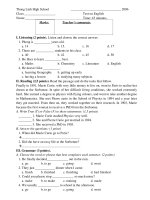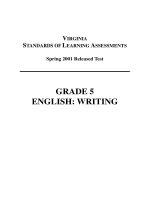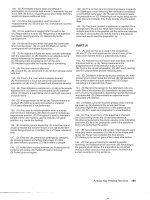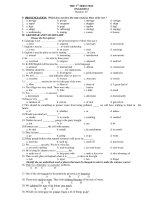Atc practist test english 10 pot
Bạn đang xem bản rút gọn của tài liệu. Xem và tải ngay bản đầy đủ của tài liệu tại đây (76.13 KB, 6 trang )
DETERMINING AUDIENCE
Knowing your audience will help you make a couple of key writing decisions, including choosing appropri-
ate words, level of formality, and level of detail—three matters of style we will discuss in more detail shortly.
If, for example, you are writing about voice recognition software and your audience is composed of
speech technology experts, then you will be able to use jargon (technical or specialized language) comfort-
ably. If you are writing for a general audience, however, you will need to avoid jargon and write in general
terms that all readers will be able to understand.
Level of formality provides another clue to the writer’s audience. The degree of formality tells you what
kind of relationship the writer has to his or her audience. If the text uses slang, for example, you can infer that
the writer has a casual, informal relationship with the reader; he is probably not writing for a general audience.
The level of detail and specificity in a text also tells you something about the writer’s intended audi-
ence. It gives you a sense of how much readers know (or are expected to know) about the topic. For exam-
ple, in the “Batman” passage you read in the pre-test, the writer provides very basic information about the
superhero. Clearly,he’s not writing for Batman buffs who would already know the history of the Batman char-
acter. By opening with “Pow! Bam! Zap!”, the writer is assuming that most readers have at some point seen
the show or read a Batman comic strip, since Batman is such a well-known character in our culture.
On the ACT English Test, you can use this awareness of audience to answer questions about word choice
and other stylistic issues. It can also help you answer questions about what kind of information should be
added to or deleted from a text. You will see examples of these kinds of questions shortly in the following
sections.
D
ETERMINING PURPOSE
As you read passages on the ACT English Test, it is important to get a clear sense of the writer’s purpose. What
seems to be the writer’s main goal? This will help you answer questions like the following, which refers to a
passage about voice recognition technology:
The writer plans to add a fifth paragraph. Which of the following would be her best choice?
a. a paragraph about the history of voice recognition technology
b. a paragraph about the cost of voice recognition software
c. a paragraph comparing features of current voice recognition programs
d. a paragraph with statistics and testimonials about the accuracy of voice recognition programs
The best paragraph to insert depends entirely upon the writer’s purpose in the passage. If, based on the
content and style of the passage, you conclude that the writer’s goal is to convince readers that voice recog-
nition software really works, then d is the best choice; it’s the paragraph that best supports the writer’s pur-
pose. If, on the other hand, the passage aims to help readers pick the best voice recognition software for them,
then c would be the best choice.
– ACT ENGLISH TEST PRACTICE–
84
Each writer has a specific purpose behind a given text, but in general, most writers write for one of the
following reasons:
Narration: To tell the story of a meaningful experience or event.
Description: To describe in detail a significant person, place, or thing.
Comparison and contrast: To show how two or more things are similar or different.
Process: To explain how something is done or should be done.
Classification/Analysis: To explain how an item fits into a particular category or to analyze
its parts.
Definition: To provide a detailed definition of a word or an idea.
Cause and effect: To explain the cause(s) or effect(s) of something.
Education: To teach a lesson or inform readers about a subject.
Evaluation: To judge the effectiveness of something.
Persuasion: To convince readers of something.
Determining purpose is a matter of determining the answer to one key question: What does this text
add up to? In other words, what is it all for? Why this information, these words, these details? What main idea
do you get from reading the text? (For more information about determining a writer’s main idea, see page
208 in the Reading Test review.)
REVISION STRATEGIES
Many questions on the ACT English Test will ask you how an addition, deletion, or other kind of revision
would affect the text. To revise means to look at something again (to re-examine) in order to improve it or
amend it. This is quite different from editing, which is correcting grammar or usage errors and was covered
in the first half of this section. Revising means carefully re-reading a text and then changing it to make it bet-
ter. Revision is concerned with content and style—what the writer says and how he or she says it. As a gen-
eral rule, writers revise first, then edit when they are sure their text says what they want to say, in the way that
they want to say it.
Revision questions on the ACT English Test focus on two key elements of effective writing:
Support. Does the passage offer sufficient support for its ideas or claims? Support can come in the form
of specific examples, facts, reasons, descriptions or anecdotes, or expert opinion and analysis. You may be
asked, for example, which of four items would best develop the support in a paragraph.
Focus. Is there a piece of the passage that seems to digress? Would removing a sentence or paragraph
improve the focus of the text? Would adding a sentence make it clear how a sentence relates to the main idea
of the passage?
For example, notice how the following paragraph loses focus:
(1)Electronic mail (e-mail) has been in widespread use for more than a decade. (2)E-mail
simplifies the flow of ideas, connects people from distant offices, eliminates the need for
– ACT ENGLISH TEST PRACTICE–
85
meetings, and often boosts productivity. (3)But e-mail should be carefully managed to avoid
unclear and inappropriate communication. (4)E-mail messages should be concise and lim-
ited to one topic. (5)It is important to be concise in business. (6)Say what you need to say as
succinctly as possible. (7)Avoid wordiness or redundancy. (8)When complex issues need to
be addressed, phone calls are still best.
Sentences 5, 6, and 7, while true, do not fit the focus of this paragraph about email. The paragraph would
be much stronger if these sentences were omitted.
BEGINNINGS, MIDDLES, AND ENDS
The ACT English Test also assesses your ability to choose effective introductory, transitional, and conclud-
ing material. You may be asked, for example, which sentence would best introduce a paragraph or which word
is the appropriate transition between two ideas.
Introductions
First impressions count, and that is why introductions are so important in writing. A good introduction:
1. Indicates what the passage is about (its topic) and what the writer is going to say about the topic (its
main idea).
2. Grabs the reader’s attention.
3. Establishes the tone of the passage.
Techniques for grabbing attention include opening with:
■
a question
■
quotation
■
a surprising fact or statement
■
an imaginary situation or scenario
■
an anecdote
■
interesting background information
■
a new twist on a familiar phrase
For example, the introduction to the Batman passage in the pretest—“Pow! Bam! Zap!”—is an open-
ing that plays upon a convention of comic strips and the Batman television series.
Transitions
Transitions are the words and phrases used to move from one idea to the next. They help words flow
smoothly and show readers how ideas relate to one another. Transitional words and phrases connect ideas
within sentences and between sentences, within paragraphs and between paragraphs. They are essential to
– ACT ENGLISH TEST PRACTICE–
86
good writing. Notice, for example, the difference between the two paragraphs below. In the first version, the
transitions have been omitted. In the second version, they are underlined.
Most people tend to think of genius as an abnormality—a “good” abnormality, but an
abnormality. Psychologists regarded the quirks of genius as too erratic to describe intelli-
gently; Anna Findley’s groundbreaking study uncovers predictable patterns in the biogra-
phies of geniuses. These do not dispel the common belief that there is a kind of supernatural
intervention in the lives of unusually talented men and women. Findley does show that all
geniuses experience three intensely productive periods in their lives, one of which always
occurs shortly before their deaths. This is true whether the genius lives to be nineteen or
ninety.
Most people tend to think of genius as an abnormality—a “good” abnormality, but an
abnormality no
netheless.Until recently, psychologists regarded the quirks of genius as too
erratic to describe intelligently; ho
wever, Anna Findley’s groundbreaking study uncovers pre-
dictable patterns in the biographies of geniuses. T
hese patterns do not dispel the common
belief that there is a kind of supernatural intervention in the lives of unusually talented men
and women. H
owever, Findley does show that all geniuses experience three intensely produc-
tive periods in their lives, one of which always occurs shortly before their deaths. T
his fact is
true whether the genius lives to be nineteen or ninety.
With the appropriate transitions, the second paragraph reads much more smoothly and makes its ideas
more clear.
Certain transitions work best for specific functions. For example, “for example” is a great transition to
use when introducing a specific example. Here’s a brief list of some of the most common transitional words
and phrases:
IF YOU WANT TO: USE THESE TRANSITIONAL WORDS AND PHRASES:
introduce an example for example for instance that is
in other words in particular specifically
in fact first (second) of all
show addition and in addition also
again moreover furthermore
show emphasis indeed in fact certainly
acknowledge another although though granted
point of view despite even though
– ACT ENGLISH TEST PRACTICE–
87
show rank more importantly above all first and foremost
show cause because therefore as a result
and effect consequently since thus
show comparison likewise similarly like
show contrast unlike however on the other hand
whereas instead rather
show the passage then next later
of time after before during
meanwhile while soon
Conclusions
Conclusions, too, should be powerful. After all, people tend to remember most what comes first and last, and
the final words have the power to ring in readers’ ears for a long time afterwards. A good conclusion will:
1. Restate the main idea.
2. Provide a sense of closure (does not “open a new can of worms” by introducing a new topic).
3. Arouse readers’ emotions to make the ending and main idea memorable.
The Batman text, again, provides a good example. The concluding sentence:
In Batman, Kane gave us an image of our own superhero potential.
This sums up what makes Batman so popular, rounding out the passage in a way that makes readers
think about their own similarities to Batman and what sort of superheroes they could be.
Many of the same introductory techniques can be used to help make conclusions memorable:
■
a quotation
■
a question
■
an anecdote
■
a prediction
■
a solution or recommendation
■
a call to action
– ACT ENGLISH TEST PRACTICE–
88
For example, the conclusion to a passage about a healthy diet might end with a call to action:
Take a good, long look in your refrigerator and pantry. What unhealthy foods call your icebox
and cabinets their home? Find them, get rid of them, and stock up with foods that will help you
live a longer, healthier life.
Practice 13
Read the passage below and answer the questions that correspond to the underlined text.
There are two main theories of punishment: retribution and deterrence. argues
that people who commit crimes deserve to be punished and that the punishment should fit
the crime. “eye for an eye” philosophy. posits that punishing offenders will
help prevent future crimes.
1. a. NO CHANGE
b. The first, retribution,
c. In the beginning, retribution
d. First and foremost, retribution
2. f. NO CHANGE
g. However, it is an
h. Also, an
j. In other words, it is an
3. a. NO CHANGE
b. According to deterrence theory,
c. Deterrence theory, on the other hand,
d. Meanwhile, deterrence theory
4. Which of the following sentences would most effectively introduce this passage?
f. Why do we punish those who commit crimes?
g. Crimes should always be punished.
h. As they say, crime doesn’t pay.
j. There is a record number of people in American prisons today.
Deterrence
ᎏᎏ
An
ᎏ
Retribution
ᎏᎏ
– ACT ENGLISH TEST PRACTICE–
89








